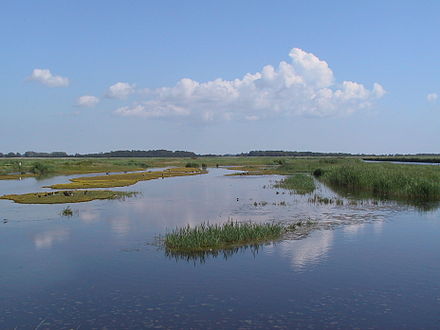History
The area, which consists of ponds, reed beds, wet meadows and small groves of trees, was originally a bay in the Baltic Sea before a spit developed and separated what became an inland lake from the sea 400 years ago.

A pond is an area filled with water, either natural or artificial, that is smaller than a lake. It may arise naturally in floodplains as part of a river system, or be a somewhat isolated depression. It may contain shallow water with marsh and aquatic plants and animals.

Reed beds are natural habitats found in floodplains, waterlogged depressions, and estuaries. Reed beds are part of a succession from young reeds colonising open water or wet ground through a gradation of increasingly dry ground. As reed beds age, they build up a considerable litter layer that eventually rises above the water level and that ultimately provides opportunities for scrub or woodland invasion. Artificial reed beds are used to remove pollutants from grey water.

A wet meadow is a type of wetland with soils that are saturated for part or all of the growing season. Debate exists whether a wet meadow is a type of marsh or a completely separate type of wetland. Wet prairies and wet savannas are hydrologically similar. Wet meadows may occur because of restricted drainage or the receipt of large amounts of water from rain or melted snow. They may also occur in riparian zones and around the shores of large lakes.
In the 19th century the area was drained by engineer and surveyor, Gustav Kröhnke, and numerous fish ponds were created over an area of 375 hectares (930 acres).
The drained lake was used for a long time for agricultural purposes before it was purchased in 1975 by the German Society for the Protection of Birds (Deutscher Bund für Vogelschutz) [1] and the district of Ostholstein. NABU bought the site in 1976 and, by 1977, it had been designated as a nature reserve.

A Naturschutzgebiet is a category of protected area within Germany's Federal Nature Conservation Act . Although often translated as 'Nature Reserve' in English, the Federal Agency for Nature Conservation (BfN) refers to them as 'Nature Conservation Areas'. It meets the criterias of a IUCN Catorry IV Habitat and Species Management Area.
This secured the protection of breeding and migrant bird species. In order to optimise the habitat for these birds, landscaping measures were carried out in several areas. The reserve also took part in a LIFE project for improving the protection of the Baltic Sea lagoons, cooperating with Danish and Swedish partners. The head of NABU's Wallnau Waterbird Reserve since March 2008 has been Malte Siegert.
In March 2010 NABU Wallnau was given responsibility for three other nature reserves on Fehmarn, thus creating a linked conservation system on the island. One reserve lay just to the north of NABU's existing nature reserve of Wallnau/Fehmarn. The two others are located between the Wallnau Nature Reserve and the NABU's Krummsteert-Sulsdorf Wiek / Fehmarn Nature Reserve. The peninsula of Spitzenort and the islands in the Lemkenhafener Wiek, which are home to inter alia a large colony of herring gulls, will also be looked after by NABU Wallnau in the future. The reserves fall under the EU's Birds Directive and are Special Areas of Conservation in the Europe-wide conservation network known as Natura 2000.
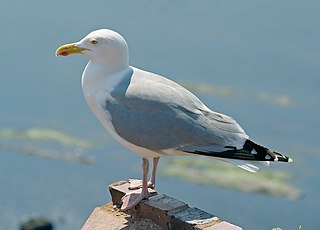
The European herring gull is a large gull, up to 26 in (66 cm) long. One of the best-known of all gulls along the shores of Western Europe, it was once abundant. It breeds across Northern Europe, Western Europe, Central Europe, Eastern Europe, Scandinavia, and the Baltic states. Some European herring gulls, especially those resident in colder areas, migrate further south in winter, but many are permanent residents, e.g. in Ireland, Britain, Iceland, or on the North Sea shores. They have a varied diet, including fish, crustaceans, and dead animals, as well as some plants.
The Birds Directive is a European Union directive adopted in 2009. It replaces Council Directive 79/409/EEC of 2 April 1979 on the conservation of wild birds which was modified several times and had become very unclear. It aims to protect all European wild birds and the habitats of listed species, in particular through the designation of Special Protection Areas.
Natura 2000 is a network of nature protection areas in the territory of the European Union. It is made up of Special Areas of Conservation and Special Protection Areas designated respectively under the Habitats Directive and Birds Directive. The network includes both terrestrial and Marine Protected Areas.
In 1970 the Love and Peace Festival, a music festival lasting several days took place on the edge of the present NABU reserve. This event was the last one at which Jimi Hendrix performed before his death. Today, a memorial stone commemorates the event.

A music festival is a community event oriented towards live performances of singing and instrument playing that is often presented with a theme such as musical genre, nationality, or locality of musicians, or holiday.

James Marshall "Jimi" Hendrix was an American rock guitarist, singer, and songwriter. His mainstream career lasted only four years, but he is widely regarded as one of the most influential guitarists in history and one of the most celebrated musicians of the 20th century. The Rock and Roll Hall of Fame describes him as "the greatest instrumentalist in the history of rock music".
Ostholstein is a district in Schleswig-Holstein, Germany. It is bounded by the districts of Stormarn, Segeberg and Plön, the Baltic Sea and the city of Lübeck.

Fehmarn is an island in the Baltic Sea, off the eastern coast of Schleswig-Holstein, Germany, and c. 18 kilometers south of the Danish island of Lolland. It belongs to the district of Ostholstein, Germany.
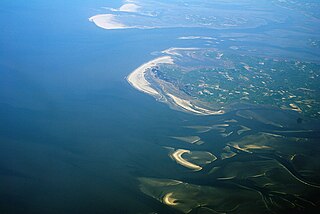
The Schleswig-Holstein Wadden Sea National Park is a national park in the Schleswig-Holstein area of the German Wadden Sea. It was founded by the Parliament of Schleswig-Holstein on 1 October 1985 by the National Park Act of 22 July 1985 and expanded significantly in 1999. Together with the Lower Saxon Wadden Sea National Park, the Hamburg Wadden Sea National Park and those parts of Elbe estuary which are not nature reserves, it forms the German part of the Wadden Sea.
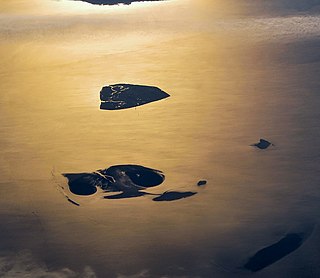
The Hamburg Wadden Sea National Park is the smallest of the three German Wadden Sea National Parks which protect the single ecological entity of the Waddensea of Hamburg reaching from Den Helder to Esbjerg.
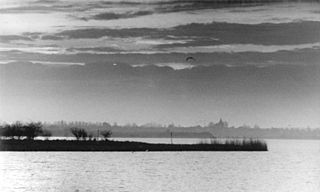
Despite its name, the Dassower See , sometimes called Lake Dassow or Dassow Bay in English, is not a lake, but a side bay, locally known as a wiek, of the Trave Fjord, northeast of Lübeck (Schleswig-Holstein) on the Baltic Sea.
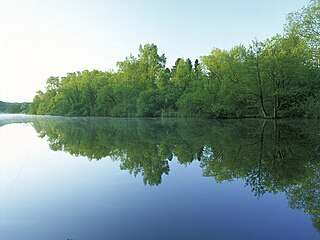
The Schwentine is a river in the North German state of Schleswig-Holstein. It is approximately 62 kilometres (39 mi) long and rises on the hill of Bungsberg, the highest point in the state, near the village of Kasseedorf in Ostholstein. It then runs from its source to Kiel where it flows into the Kiel Fjord, a bay of the Baltic Sea. It passes through several lakes, including the Großer Plöner See, the largest lake in Schleswig-Holstein, as well as the towns Eutin, Malente, Plön, Preetz and Kiel.

The Selenter See is the second-largest lake in the North German state of Schleswig-Holstein, after the Großer Plöner See. It lies at an elevation of 37 m above sea level (NN) and has an area of 22.4 km².

The Lower Saxon Wadden Sea National Park was established in 1986 and embraces the East Frisian Islands, mudflats and salt marshes between the Bay of Dollart on the border with the Netherlands in the west and Cuxhaven as far as the Outer Elbe shipping channel in the east. The national park has an area of about 345,800 hectares (1,335 sq mi). The National Park organisation is located in Wilhelmshaven. Since June 2009 the Lower Saxon Wadden Sea National Park has become a UNESCO World Heritage Site along with the Schleswig-Holstein Wadden Sea and the Dutch Wadden Sea.
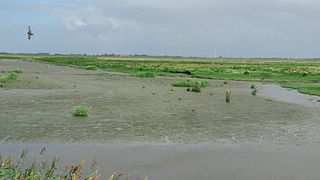
The Katinger Watt is an area near Kating in the south of the Eiderstedt peninsula in the north German state of Schleswig-Holstein which is partly maintained by the German Nature and Biodiversity Conservation Union, NABU. The Katinger Watt is part of two larger protected areas, of the Ramsar site Schleswig-Holstein Wadden Sea and adjacent areas and of a similarly named SPA.

The Dithmarscher Eiderwatt, officially the Dithmarscher Eidervorland mit Watt, is a nature reserve in the districts of Dithmarschen and Nordfriesland in the north German state of Schleswig-Holstein. The site has an area of 620 hectares which consists of the mudflats on the tidal current of the river Eider.

The Lebrade Pond Bird Sanctuary is a nature reserve in the north German state of Schleswig-Holstein, that lies within the district of Plön, about 7 kilometres north of the town of Plön. The reserve is part of the Holstein Switzerland Nature Park and covers an area of about 144 hectares. It has been designated as a Special Area of Conservation and therefore is part of the Natura 2000 network. It has a length of about 1.7 kilometres and a width of about one kilometre.

Süderoog is one of the Halligen, a group of islands in the North Frisian Wadden Sea, off the west coast of Schleswig-Holstein in north Germany. It belongs administratively to the parish of Pellworm and is a bird reserve.
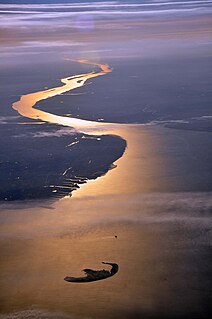
Trischen (help·info) is an uninhabited island in the Meldorf Bay, about 14 kilometres off the North Sea coast of Dithmarschen in north Germany – about 12 kilometres from the Trischendamm embankment. The island belongs to the municipality of Friedrichskoog and is only occupied from March to October by a bird warden from the Nature and Biodiversity Conservation Union or NABU. Otherwise it is out-of-bounds. Trischen originated about 400 years ago and moves about 3 m per month towards Büsum on the mainland.

The Schwentine Oxbow Lake is an area around part of the River Schwentine between Raisdorf and Klausdorf that was designated a nature reserve in 1984. It received this conservation status because the waterbody has remained close to its natural state due to its steep river banks and is a habitat for a range of rare plants and animals. It covers an area of 19 hectares. In addition to the section of river it includes an oxbow lake, a tributary, hedgerows, wooded river banks and slopes, rich in herbs, and small ponds.

Tourism is an important economic factor for Germany's northernmost state of Schleswig-Holstein.

The Neuendorfer Wiek and Beuchel Island Nature Reserve is a nature reserve on the German Baltic Sea island of Rügen in the state of Mecklenburg-Vorpommern. It is 550 hectares in area. The island of Beuchel was designated as a reserve on 25 July 1940. In 1999 and 2004 it was extended to include the bay of Neuendorfer Wiek.

Hamburger Hallig is an area on the westcoast of Nordfriesland district in Schleswig-Holstein, Germany, that is not protected by sea dikes. It is therefore counted among the Halligen islands.

The Delver Koog is a koog, about 1,200 hectares in area, that is dominated by agricultural grassland and through which one of the large bends of the River Eider meanders. It contains one of the 10 nature reserves in the Eider-Treene Depression in the western part of the German state of Schleswig-Holstein. Since 1976, an area of 190.1 hectares has been protected as a nature reserve. The koog is part of the municipality of Delve in the county of Dithmarschen.

The Wernau Quarry Ponds are a Nature Conservation Area established by the Stuttgart Regional Commission on June 5, 1981. They are located within the jurisdiction of Wernau and Wendlingen and the community of Köngen, which are located in the district of Esslingen in the German state of Baden-Württemberg.
